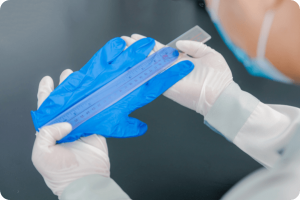Several groups have stepped up to fill the need with the current demand for certain personal protective equipment (PPE), outstripping supply in many states due to the pandemic. As a result, PPE manufacturers have dramatically expanded production.
In effect, other companies that are not usually associated with PPE, like garment manufacturers, are now converting their factories to manufacture products like PPE gloves. This is to support the alleviating demand for protective gear.
There are 4 kinds of PPE gloves used in the medical sector, and they are produced and tested in similar ways. In this article, we will be discussing the different types of disposable medical gloves. Especially how they are manufactured and what type of testing they go through.
4 Types of Gloves
Nitrile, latex, polyvinyl chloride, and polychloroprene are the 4 common types of PPE gloves. Here is the description of each medical glove.
Latex
Latex gloves are made from natural rubber. The raw material, rubber tree sap, is procured and preserved with ammonia. Then it is concentrated on getting rid of water and impurities. After mixing it with additional processing chemicals, latex is good to go for gloves production. These gloves are the most elastic and resilient type, plus they are biodegradable.

In addition, latex gloves yield the highest level of protection against viruses. However, they can also be an allergen to certain people and create allergies for people who are constantly exposed to latex over time.
Vinyl
Vinyl gloves are excellent for low-risk situations because they do not provide much protection from harmful pathogens. These are the least expensive type of gloves, but they do not fit well like other types.
Nitrile

Nitrile gloves come from NBR (nitrile butadiene rubber), a copolymer. Butadiene and acrylonitrile are combined in a copolymerization process to produce this material. As a result, nitrile gloves are more substantial and wear better than latex while offering a better fit and more dexterity compared to vinyl. They also protect against chemicals and viruses.
Neoprene
Neoprene gloves are made up of carbon, chlorine, and hydrogen, crosslinked as polymers using sulfur. These gloves are not as commonly used, but they mix the properties of nitrile and latex. They provide a good fit and are durable and free of allergens while delivering protection from chemicals and bodily fluids.
How the Gloves are Manufactured
Whatever the type of your PPE gloves is made of, they are produced in the same fundamental way.
The production begins with hand-shaped ceramic or aluminum molds on a conveyor dipped in wash tanks with hot water, chlorine or bleach, and then dried. This dipping gets rid of any possible residue from the previous batch of medical gloves. Once the molds are cleaned, they are coated to make the rubber stick. To attain this, the molds are immersed into a mixture of calcium nitrate solution and calcium carbonate.
Then, a second drying occurs, and the glove forms dip into tanks of either nitrile, latex, or polyvinyl chloride. This is when the methods begin to differ because the materials must be manufactured differently.
Latex Gloves
Latex gloves have their thickness ascertained by how long they remain in the tank. Once the forms are out, they spin to put away excess rubber and then be washed in chlorine and hot water. This method removes extra latex and chemicals to lessen the severity of any allergic reactions. The forms are then dried and cured using vulcanization, interlinking the rubber molecules to strengthen the gloves.
After a second rinse to put away any more excess latex, the gloves go through a series of brushes that roll their ends into cuffs. They are then removed using air jets. Once they are off the molds, the gloves can be tested and shipped.
Nitrile and Vinyl Gloves
Nitrile and vinyl gloves are also dipped in a tank filled with liquid rubber and baked to form and dry.
These gloves then may undergo chlorination or polymer coating to make them easier to put on and take off. However, chlorination makes them more complicated and more slippery. They can also be polymer-coated, which lubricates them. Once the coatings are added, gloves are stripped from the molds, usually by human workers, since synthetic rubber is stickier than latex. The gloves can then be tested.
Glove Testing
There are two things gloves must go through:
- PPE gloves must meet regulatory requirements to be certified as medical-grade before they can go onto the market. Once these conditions are met, each batch of gloves is given simple tests to guarantee quality.
- Apart from the tests that must be performed on each glove batch, regulatory tests prove the gloves being manufactured are safe enough to merit a medical rating. For example, all gloves must pass a dimension test. The glove must fulfill the length between the middle fingertip and cuff, the palm’s width, and a particular thickness requirement. These measurements rely on glove type and size.

Gloves must also pass sterility tests and aging tests, which require a glove to meet tensile and elongation performance standards after being heated at 70°C and 100°C for a specific number of hours. The powder amount must also be less than 2 mg per glove. Latex gloves must also pass additional tests for antigenic protein content and aqueous extractable protein content.
Conclusion
If you are part of the medical industry or other relevant organizations looking for PPE gloves, check out our website http://gymdappe.com/. You can rely on us when it comes to your PPE needs. Contact us today!



